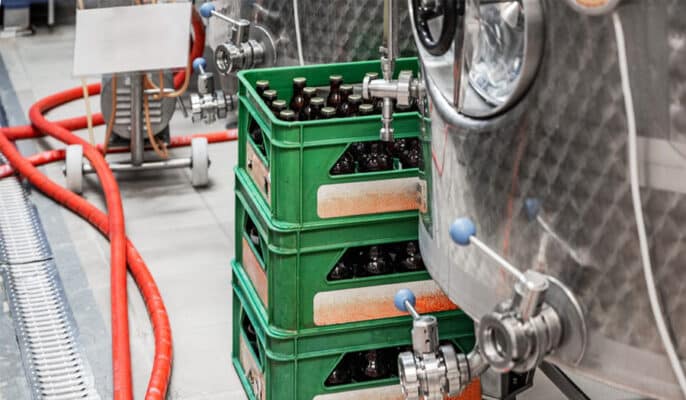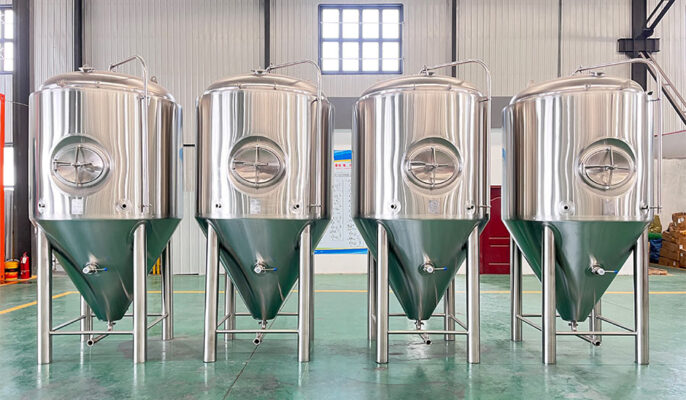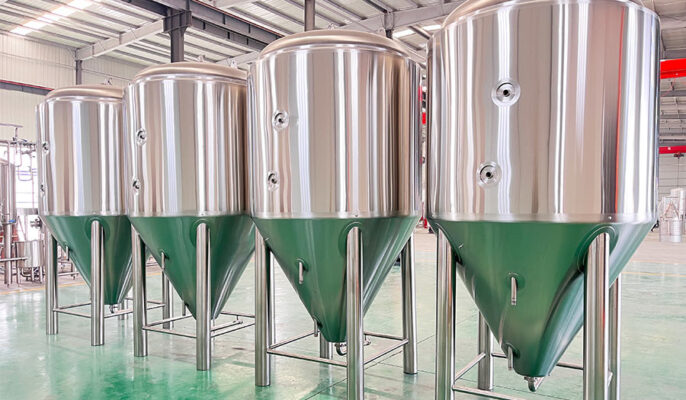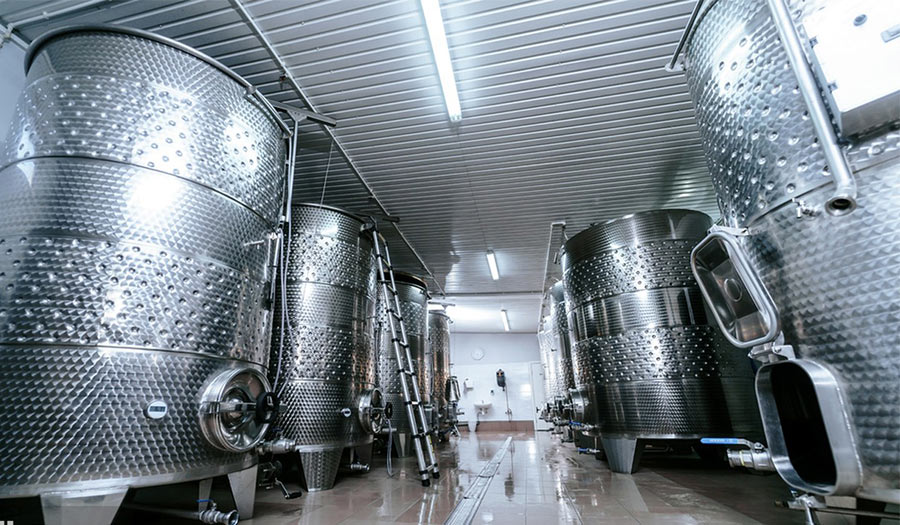In beer brewing, fermentation is the key link that determines the quality of the final product, and choosing the right gistingsvat is even more important. Different types of containers have their advantages in material, shape, and function, which directly affect the performance of yeast, alcohol output, and flavor complexity. By deeply understanding the characteristics of these containers, brewers can choose the most suitable fermentation tools according to their needs and technical level to ensure the brewing of high-quality beer.
The concept of fermentation
Fermentation refers to the process in which sugars are converted into alcohol and carbon dioxide under the action of microorganisms. In this process, yeast is the most critical participant. They are responsible not only for converting sugars into alcohol but also for affecting the flavor, aroma, and taste of beer. Therefore, choosing a suitable fermentation container is crucial.
Wat is een gistingsvat?
Fermentation vessels are containers used to contain and promote the fermentation process of various beverages. During the fermentation process, yeast or bacteria consume sugars and convert them into alcohol or acid depending on the type of beverage. The right container affects the fermentation process and thus the final taste and quality of the product.
During the fermentation process, the container needs to meet the following basic requirements:
- Sealing: Prevent oxygen and contaminants from entering while allowing carbon dioxide to escape to avoid excessive pressure.
- Material: Common materials include stainless steel, glass, plastic, and wood. Each material has a different effect on the flavor and stability of the wine.
- Temperature control: The design of the container should support temperature control to ensure that the yeast ferments at the optimal temperature to obtain the ideal flavor and alcohol concentration.
- Easy to clean: The fermentation container needs to be easy to clean and disinfect to prevent residues and bacteria from affecting the fermentation quality.

Main types of fermentation vessels
Roestvrij staal fermentatietanks
Stainless steel fermentation tanks are a popular choice for home brewers and commercial breweries. They are durable, easy to clean, and have excellent temperature control. These containers prevent oxygen intrusion and ensure consistency in the fermentation process.
- Advantages: Easy to clean and maintain, able to withstand high temperatures and pressures, suitable for large-scale brewing.
- Disadvantages: Higher price means larger initial investment.
Plastic fermentatietanks
Plastic fermentation tanks are lightweight and affordable. Plastic fermentation tanks are ideal for beginners or those on a budget. However, plastic fermentation tanks may not provide the same level of insulation and light protection as other materials.
- Advantages: Easy to move and clean, transparent design for easy observation of the fermentation process.
- Disadvantages: Long-term use may absorb odors, and food-grade plastics need to be selected.
Glass bottle fermentation vessel
Glass carafes are a classic choice for home brewers, prized for their beauty and ability to maintain flavor integrity. However, they can be heavy and fragile and need to be handled with care.
- Advantages: Not easy to react with liquids, good sealing, transparent for easy observation.
- Disadvantages: easy to break, limited capacity, suitable for small batch brewing.
Barrels
Barrels are often used to age spirits, wines, and sour beers. They give beverages a unique flavor, adding complexity and personality. However, they require regular maintenance and are expensive.
- Advantages: can provide beer with a unique flavor and is suitable for long-term storage.
- Disadvantages: require regular maintenance and are susceptible to microbial contamination.
How to use fermentation vessels?
The process of using a fermentation vessel involves several key steps to ensure a smooth fermentation and high-quality wine. Here are a few key steps for using a fermentation vessel:
- Cleaning and Disinfection: Before use, thoroughly clean the container and its accessories and disinfect them with appropriate disinfectants to prevent contamination.
- Add raw materials: Pour raw materials such as malt, sugar, yeast, and water into the fermentation container according to the recipe and stir evenly.
- Control temperature: Make sure the fermentation container is placed in a suitable temperature range to support the activity of yeast. Different types of beer require different temperatures.
- Sealed container: Use a sealing lid and air valve to seal the container to ensure that gas can escape but does not allow outside air to enter to prevent contamination.
- Monitoring: Regularly check the status of fermentation, including the generation of foam, bubbles, and temperature changes, to ensure that fermentation is proceeding normally.
- Secondary fermentation: After the primary fermentation is over, if secondary fermentation is required, the beer can be transferred to another container to remove precipitation and impurities.
- Cleaning and maintenance: After the fermentation is over, clean the container in time to prevent residues from affecting the next use.

What factors should be considered when choosing a fermentation vessel?
Grootte en capaciteit
When choosing a fermentation vessel, the size of the vessel must match the batch size you are brewing. Make sure the vessel has enough headroom to contain the foam and gas produced during the fermentation process and avoid overflow. At the same time, the right size can also help improve fermentation efficiency and ensure that the yeast can work in the best environment.
Material and durability
Different materials have their advantages and disadvantages, so when choosing a container, you should fully consider its durability, insulation properties, and impact on the taste of the beverage. For example, stainless steel containers are corrosion-resistant and easy to clean, which is suitable for large-scale brewing; while glass containers have less impact on flavor but are more prone to cracking. Understanding the characteristics of each material can help you make an informed choice.
Temperatuurregeling
The fermentation temperature is crucial to the activity of yeast and the flavor of beer. Some fermentation vessels are equipped with built-in temperature control functions, which can be precisely adjusted to meet the needs of different types of beer. Other fermentation vessels may require additional equipment, such as cooling jackets or temperature control systems, to maintain the appropriate fermentation temperature. Choosing the right temperature control equipment can significantly improve brewing results.
Reiniging en desinfectie
The design of the fermentation vessel should provide easy access to the interior, which is crucial for thorough cleaning and disinfection. Make sure the opening of the fermentation container is large enough to facilitate the use of cleaning tools and avoid the breeding of residues and bacteria. At the same time, the container should be easy to disassemble and assemble to facilitate daily maintenance and ensure that each use is carried out under optimal hygienic conditions, thereby improving the quality of the final product.
Fermentation vessel size selection
- Small container: suitable for home brewing and experimental brewing, usually between 5-50 liters. Small containers are easy to move and clean, suitable for beginners.
- Medium container: suitable for small and medium-sized brewing, usually between 50-1000 liters. This container can meet the needs of family gatherings and small businesses.
- Large container: commonly used in commercial brewing, usually above 500 liters. It can be mass-produced but requires professional equipment and technical support.

FAQ
What type of container is best for beer fermentation?
The best containers for beer fermentation are usually closed stainless steel fermenters because they effectively prevent oxygen and contaminants from entering while controlling temperature and pressure.
How should the size of the container be selected?
The size of the container should match the size of the batch, ensuring that there is enough headspace to accommodate the foam generated during the fermentation process to avoid overflow.
Hoe regel je de fermentatietemperatuur?
Some fermentation vessels are equipped with built-in temperature control systems, while other vessels may require additional equipment (such as cooling jackets) to regulate the temperature to maintain the optimal fermentation environment.
What is the best way to clean the fermentation container?
Wash the container thoroughly with an unscented detergent and hot water, and then disinfect it with a suitable disinfectant to ensure that it is hygienic before and after use.




